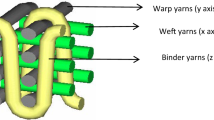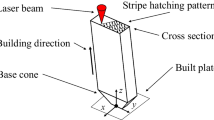Abstract
The present work aims to investigate experimentally the crack arrest capability and dynamic fracture mechanisms under impact loading of three commercial, rubber-toughened (RT) PMMA grades differing by their rubber nano-particle concentration and resulting Charpy impact toughness. For that purpose, Kalthoff and Winkler (KW)-like impact tests were performed using gas launcher considering impact velocities ranging between 20 and 100 m/s. A high-speed camera was used to record the projectile/specimen interaction and the progressive failure of the specimen. The fracture surfaces of the fragments were observed using a scanning electron microscope (SEM). It is seen that the higher the impact velocity the larger the number of fragments. On the other hand, it is shown that increasing the rubber nano-particle concentration favors the crack arrest capability under impact loading by promoting inelastic deformation, reducing the crack propagation velocity, limiting crack multi-branching, and reducing the number of fragments.


















Similar content being viewed by others
References
Abdel-wahab AA, Ataya S, Silberschmidt VV (2017) Temperature-dependent mechanical behaviour of PMMA?: Experimental analysis and modelling. Polym Test 58:86–95
Arruda EM, Boyce MC, Jayachandran R (1995) Effects of strain rate, temperature and thermomechanical coupling on the finite strain deformation of glassy polymers. Mech Mater 19:193–212
Awaja F, Zhang S, Tripathi M, Nikiforov A, Pugno N (2016) Cracks, microcracks and fracture in polymer structures?: Formation, detection, autonomic repair. Prog Mater Sci 83:536–573
Ayre DS, Bucknall CB (1998) Particle cavitation in rubber-toughened PMMA: experimental testing of the energy-balance criterion. J Polym 39:4785–4791
Brown HR, Schneider JA, Murphy TL (2014) Experimental studies of the deformation mechanisms of core-shell rubber-modified diglycidyl ether of bisphenol-A epoxy at cryogenic temperatures. J Compos Mater 48:1279–1296
Bucknall CB, Partridge IK, Ward MV (1984) Rubber toughening of plastics. J Mater Process Technol 19:2064–2072
Cheng SK, Chen CY (2004) Mechanical properties and strain-rate effect of EVA/PMMA in situ polymerization blends. Eur Polym J 40:1239–1248
Chou SC, Robertson KD, Rainey JH (1973) The effect of strain rate and heat developed during deformation on the stress-strain curve of plastics. Exp Mech 13:422–432
Chung JS, Choi KR, Wu JP (2001) Effect of polybutyl acrylate-polymethyl methacrylate rubber particle texture on the toughening behavior of polymethyl methacrylate. Korea Polym J 9:122–128
Farrokh B, Khan AS (2010) European Journal of Mechanics A / Solids A strain rate dependent yield criterion for isotropic polymers?: Low to high rates of loading. Eur J Mech A Solids 29:274–282
Gilbert JL, Ney DS, Lautenschlager EP (1995) Self-reinforced composite polymethyl methacrylate: static and fatigue properties. Biomaterials 16:1043–1055
Gong S, Bandyopadhyay S (2007) Fracture properties and fracture surface morphologies in rubber-PMMA composites. J Mater Eng Perform 16:607–613
Hsieh AJ, Deschepper D, Moy P, Dehmer PG, Song JW (2004) The effects of PMMA on ballistic impact performance of hybrid hard/ductile all-plastic- and glass-plastic-based composites, ARL report
Hu W, Guo H, Chen Y, Xie R, Jing H, He P (2016) Experimental investigation and modeling of the rate-dependent deformation behavior of PMMA at different temperatures. Eur Polym J 85:313–323
Jancar J, Hoy RS, Jancarova E, Zidek J (2015) Effect of temperature, strain rate and particle size on the yield stresses and post-yield strain softening of PMMA and its composites. Polymer 63:196–207
Jerjen I, Revol V, Brunner AJ, Schuetz P, Kottler C, Kaufmann R, Luethi T, Nicoletti G, Urban C, Sennhauser U (2013) Detection of stress whitening in plastics with the help of X-ray dark field imaging. Polym Test 32:1094–1098
Kalthoff JF, Winkler S (1987) Failure mode transition at high rates of loading, In: Proc. Int. Conf. Impact Load. Dyn. Behav. Mater. Chiem CY, Kunze H-D, Meyer LW (eds), Bremen, pp 185–195
Kilwon C, JaeHo Y (1998) Chan Eon Park, The effect of rubber particle size on toughening behaviour of rubber-modified poly(methyl methacrylate) with different test methods. J Polym 39:3073–3081
Kobayashi AS (1979) Rapid crack propagation and arrest in polymers. Polym Eng Sci 19:131–135
Lalande L (2007) Structure et mécanismes de microdéformation de polyméthylméthacrylates renforcés au choc, Ph.D. Thesis, École polytechnique fédérale de Lausanne
Mbarek IA, Matadi Boumbimba R, Rusinek A, Voyiadjis GZ, Gerard P, Samadi-Dookic A (2018) The dynamic behavior of polymethyl methacrylate based nano-rubbers subjected to impact and perforation: experimental investigations. Mech Mater 122:9–25
Miwa M, Takeno A, Hara K, Watanabe A (1995) Volume fraction and temperature dependence of mechanical properties of silicone rubber particulate/epoxy blends. Composites 26:371–377
Nasraoui M, Forquin P, Siad L, Rusinek A (2012) Influence of strain rate, temperature and adiabatic heating on the mechanical behaviour of poly-methyl-methacrylate?: Experimental and modelling analyses. Mater Des 37:500–509
Ognedal AS (2012) Large-deformation behaviour of thermoplastics at various stress states, Ph.D. Thesis, Department of Structural Engineering, Norwegian University of Science and Technology
Patent No : EP0776931
Pearson RA, Yee AF (1991) Influence of particle size and particle size distribution on toughening mechanisms in rubber-modified epoxies. J Mater Sci 26:3828–3844
Plummer CJG, Béguelin P, Kausch HH (1999) Microdeformation in core-shell particle modified polymethylmethacrylates. Colloids Surfaces 153:551–566
Porfyrakis K, Assender HE, Robinson IM (2002) The interrelationship between processing conditions, microstructure and mechanical properties for injection moulded rubber-toughened polymethyl methacrylate RTPMMA samples. J Polym 43:4769–4781
Ravi-Chandar K, Lu J, Yang B, Zhu Z (2000) Failure mode transitions in polymers under high strain rate loading. Int J Fract 101:33–72
Roux E, Longère P, Cherrier O, Millot T, Capdeville D, Petit J (2015) Analysis of ASB assisted failure in a high strength steel under high loading rate. Mater Des 75:149–159
Shioya T, Koga Y, Fujimoto K, Ishida R (1988) Micro-mechanism of dynamic crack propagation in brittle materials. J Phys Colloq 49:253–260
Smirnov I, Sudenkov Y (2013) Crack propagation in PMMA plates under various loading conditions. In: The 13th international conference on fracture, June 16-21, Beijing, China, pp 1–10
Todo M, Takahashi K, Ben Jar P, Beguelin P (1999) NII-Electronic Library Service. Jpn Soc Mech Eng Int J 42:585–591
Wang Q, Lee D (1999) Predictive modelling for rubber-toughened polymers. Mech Mater 31:705–716
Wang X, Ming K, Xiao LIN, Ye Y, Mai CH, Wang LRF (2000) Rose, modelling mechanical properties of core-shell rubber-modified epoxies. Acta Mater 48:579–586
Wu H, Ma G, Xia Y (2004) Experimental study of tensile properties of PMMA at intermediate strain rate. Mater Lett 58:3681–3685
Acknowledgements
The authors would like to acknowledge the technical assistance of ICA technical team and Centre de MicroCaractérisation Raimond Castaing UMS 3623 as well as some financial support provided by AIRBUS Helicopters.
Author information
Authors and Affiliations
Corresponding author
Additional information
Publisher's Note
Springer Nature remains neutral with regard to jurisdictional claims in published maps and institutional affiliations.
Rights and permissions
About this article
Cite this article
Jali, N.M., Longere, P. Experimental investigation of the dynamic fracture of a class of RT-PMMAs under impact loading. Int J Fract 225, 219–237 (2020). https://doi.org/10.1007/s10704-020-00475-x
Received:
Accepted:
Published:
Issue Date:
DOI: https://doi.org/10.1007/s10704-020-00475-x




